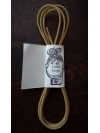The production of Cordoni in Rome, in the seventeenth century, is documented by numerous testamentary acts of Roman string makers, collected by Patrizio Barbieri, but so far it was unknown how they were made: it was known only that they were intended for the bass of musical instruments.
It was only thanks to my dear friend Adrien Alix, gambista and contrabassista, that I came to know of a document of the end of the sixteenth century, of a subject, moreover, foreign to the historical string making art, in which incidentally the author explains how the cordons were made: only two strands, but twisted to the maximum.
In reality the document does not say everything, and there is an additional secret that obviously I cannot reveal, thanks to which we can make strings identical to those of the few surviving iconographic examples, that is characterized by a non-smooth surface, but with the twisting of the guts in strong relief: it is only thanks to this secret that the Cordoni di Roma can become competitive bass with the successive strings silver wound, both for power and for quickness of attack and sonority.
In conclusion we are dealing with strings suitable for those who want to perform baroque music in a strictly historical way, without giving up a powerful and rich sound for bass.
I can't say if the Cordoni di Roma or those I invented are better, the Cordoni Cordedrago, which are really powerful and rich in tone even when they are very big.
I can only recommend the Cordoni di Roma to those who really want to hear how the instruments sounded before the invention of the wound strings, also to experiment with the theoretical limits of the instrument's format and the technical and virtuosic possibilities, that is, for specifically philological needs. However also the sound quality is excellent, above all, as I said, for the transitional strings like the DO of the Renaissance bass and Baroque bass.
For the bigger strings I continue to prefer my Cordoni Cordedrago, for their power and depth, but also those of Rome work very well.





